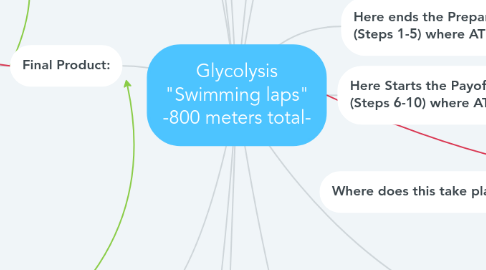Glycolysis "Swimming laps" -800 meters total-
作者:Matthew Andresen


1. Step 1: Glucose
1.1. The first stage is catalyzed by an enzyme called hexokinase, which to transfer phosphates (through phosphorylation) into Glucose 6 phosphate
1.2. There is a breakdown of ATP to create ADP
2. Step 2:
2.1. The isomer Phosphoglucose isomerase converts Glucose 6 phosphate into Fructose 6 phosphate .
3. Step 3:
3.1. an ATP molecule donates a high energy phosphate to Fructose 6 phosphate which (Using the enzyme phosphofructokinase) is created into Fructose 6-biophosphate
4. Step 8:
4.1. 3-phosphoglycerate is converted into 2 - Phosphoglycerate via enzyme called Phosphoglycerate mutase which acts as a catalyst to move a functional group to another position.
5. Step 9:
5.1. 2-Phosphoglycerate is converted to Phosphoenolpyruvate (PEP) via an enzyme called Enolase, through a dehydration reaction where 2-phosphoglycerate loses its water which creates a double bond
5.2. H2O is created as a by product in this reaction
6. Step 10
6.1. Phosphoenlpyruvate (PEP) is created into the final step of Glycolysis called Pyruvate.
6.2. It is converted through an enzyme called Pyruvate kinase
6.3. This final step results in the creation of a second ATP molecule
7. Final Product:
7.1. A Pyruvate is the final product of Glycolysis
7.2. At the end 2 (3-carbon pyruvate molecules) are produced
7.3. A Total of 4 ATP are created With a Net total of 2 ATP
7.4. Two NADH molecules are also produced.
8. Anabolism
8.1. Anabolism is the way the body uses the energy that is released in a catabolic reaction. This is the creation of molecules.
8.2. An example of Anabolism in Glycolysis might be the first five steps where ATP is consumed to make more complex molecules from simpler ones
8.3. An example of this could be when Adenosine Diphosphate (ADP) is created into Adenosine triphosphate (ATP), because a more complex molecule is being created out of a simpler one.
9. Potential Energy
9.1. Potential Energy is all of the energy that is stored. It is energy just waiting to be used.
9.2. A generic example of Potential energy could be the the bonds that hold together the molecules (such as the molecules that create glucose)
10. Kinetic Energy
10.1. Kinetic energy is the energy when something is moving. Anything in motion has kinetic energy
10.2. The whole activity of swimming is releasing kinetic energy, and more specifically when ever a bond is broken, energy is released.
11. Allosteric regulation
11.1. Allosteric regulation is a form of enzyme inhibitor in which something (the inhibitor) binds to the enzyme in a location other then the active site.
11.2. ATP binds to the allosteric sites on the enzyme Phosphofructokinase and either inhibits or increases the affinity.
12. Feedback inhibition
12.1. This is the suppression of inhibition of enzymes, thus slowing or inhibiting the enzymes actions.
12.2. An example of Feedback inhibition occurs when large quantities of Glucose 6 phosphate are created. Hexokinase watches and inhibits the production (slowing it down) if to much is created.
13. Endergonic Reaction
13.1. In an Endergonic reaction is a form of chemical reaction in which the free energy released is positive. An additional driving force is required to move the process along though.
13.2. This could also be known as a anabolic reaction.
13.3. An example of this could be the hydrogen atom is separated from 3-G-P in which phosphoglyceric acid is left behind.
14. Exergonic Reaction
14.1. An Exergonic is another form of chemical reaction in which the free energy released is negative. This reaction is also known as a "spontaneous reaction" because no other additional energy is needed.
14.2. An example of this being when hexokinase phosphorylates glucose to form glucose 6 phosphate. This overall reaction is a Exergonic reaction.
15. Krebs Cycle
15.1. The Krebs Cycle occurs in the Mitochondria Matrix in the Cell
15.2. Result: * 6x NADH * 2X FADH2 * 2X GDP * 4X CO2 (Note that this is after 2 cycles)
16. (Part 3): Acetal-CoA in the Krebs Cycle
17. Citrate
18. Cis-Aconitase
19. D -Aconitase
20. Alpha -Ketogintrate
21. Succynl-CoA
22. Succinate
23. Fumarate
24. Malate
25. Oxaloacetate
26. FADH2
26.1. It should be noted that between Succinate and Fumarate is the only location where FADH2 is produced from FAD
27. Oxidative Phosphorylation
27.1. This highly complex and crucial process takes place within the inner Mitochondrial membrane
28. Complex 1
28.1. This chain begins when the NADH (created in both Glycolysis and the Krebs cycle) enters the into complex 1. This NADH becomes NAD+ after it releases 2 electrons into Complex 1
28.2. 4 protons are pumped out of Complex 1 and out of the matrix
29. Complex 3
29.1. The electrons now enter Complex 3 resulting in 4 more protons to be pumped out of the matrix.
30. Complex 4
30.1. These electrons are then transferred to Complex 4 where 2 more protons are pumped out of the matrix.
31. Complex 2
31.1. FADH2 (produced in the Krebs Cycle) enters the Electron transport chain now. During this stage it releases 2 high energy electrons into Complex 2, becoming FAD+
32. (Part 2) Pyruvate Oxidation:
32.1. This occurs within the mitochondrial matrix
32.2. In this stage the pyruvate molecule created in glycolysis is oxidized into Acetal-CoA (which will be an important first step in the Citric Acid Cycle --aka--Krebs.)
32.3. This oxidation of the pyruvate molecule results in the creation of a NADH molecule and a CO2 molecule. The NADH molecule will be used in Oxidative Phosphorylation later on
33. Step 4:
33.1. Fructose 6 bisphosphate is cleaved by a enzyme called aldolase into Dihydroxyacene phosphate
34. Step 5:
34.1. Dihydroxtacene phosphate breaks down into Glyceraldehyde 3 phosphate through the enzyme Triose phosphateIsomerase.
35. Step 6:
35.1. The sugar Glyceraldehyde 3 phosphate is oxidized courtesy to the enzyme Glyceraldehyde 3 phosphate dehydrogenase
35.1.1. These high energy protons released by the oxidation are collected by NAD and transformed into NADH
